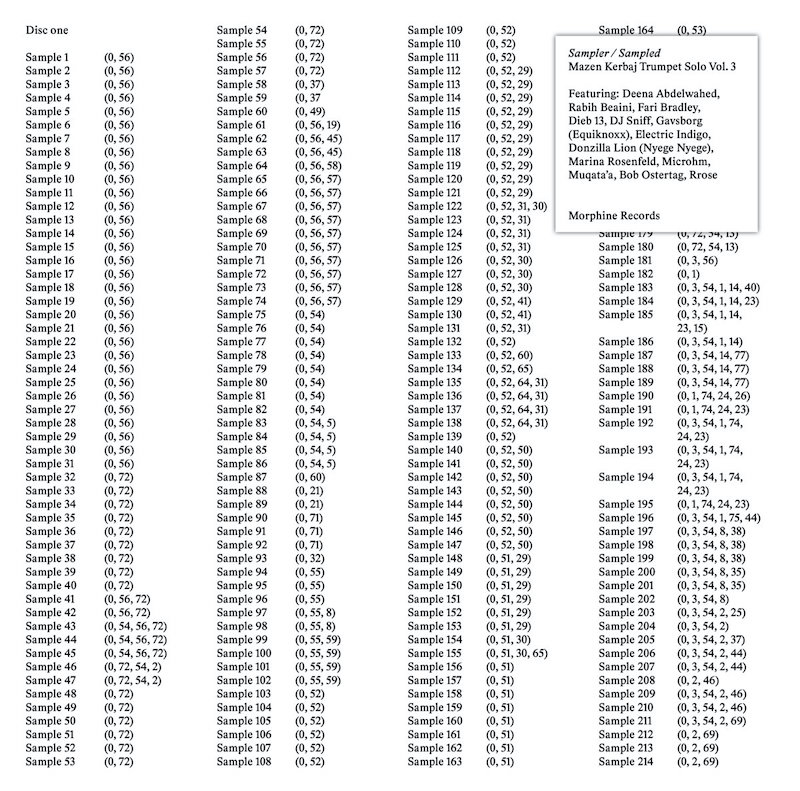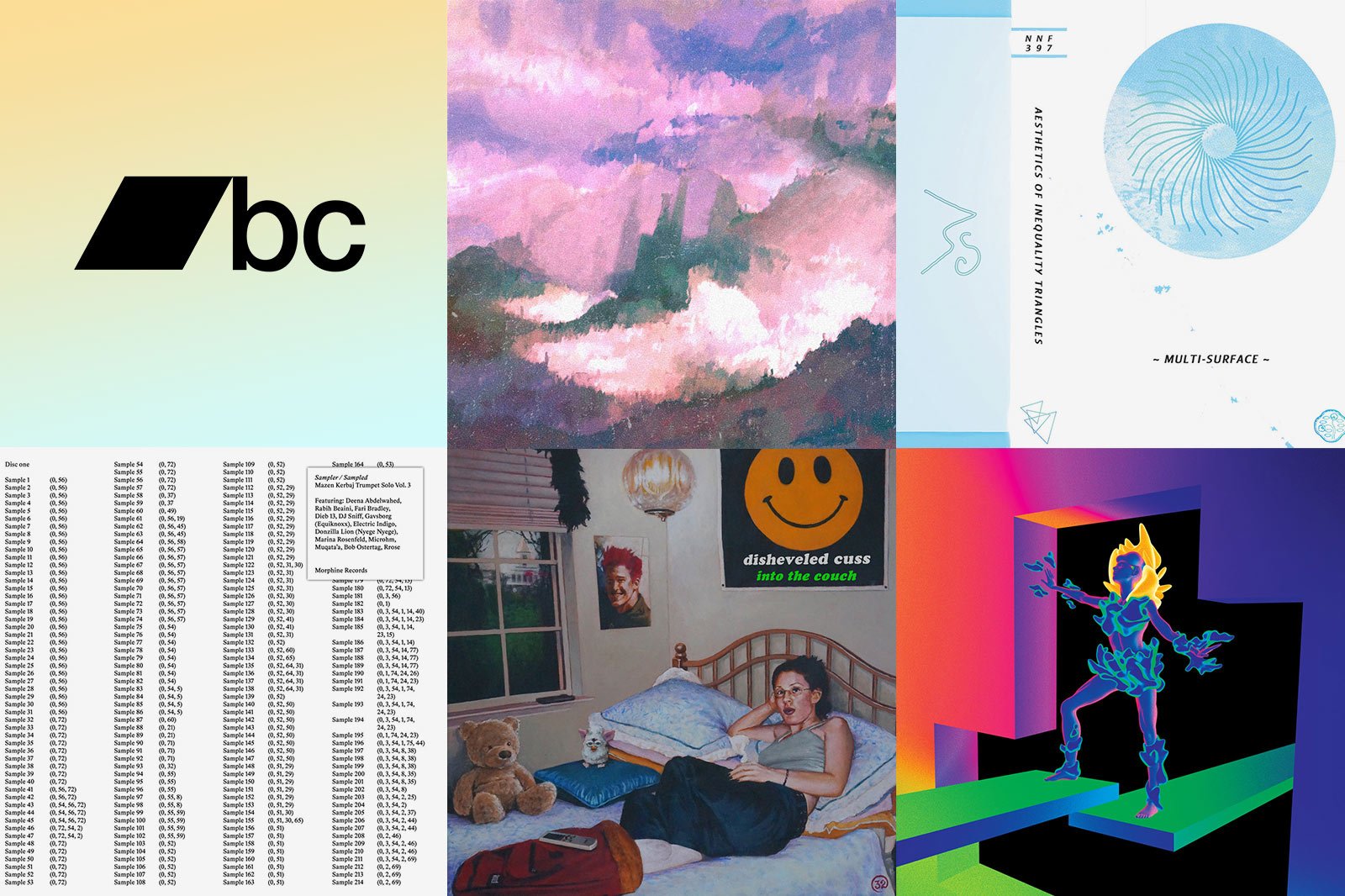Bandcamp Friday is back—today, all revenue generated on Bandcamp goes directly to the artists and labels who created the music. Take some time to browse Bandcamp today to find some new music—and feel free to take our recent favorites below as a starting point for your sound surfing.
Cross-Cultural Sampling: Mazen Kerbaj's Sampler / Sampled
A lot can be said about samplers. Without a doubt, the sampler is one of those musical instruments that redefined the way humans approach making music and interact with sounds altogether. A sampler is such a versatile tool that it invites countless highly personalized workflows and creative approaches, with the scope of musical applications is seemingly inexhaustible. Modern samplers become centerpieces for music-making for the last thirty years, however, the instrument itself evolved out of a technique that had already been explored and refined by artists and engineers for decades, migrating from one piece of technology to another until it firmly solidified in digital form. Mzen Kerbaj's Sampler/Sampled is in many ways an ode to this instrument, yet more—here, the instrument is utilized as a vehicle for a transcultural genre-melting collaboration.

Let's start with a short background of the artist-initiator. Mazen Kerbaj is a Lebanese artist whose practice encompasses authoring comic books, creating illustrations, and making music. Active since the early 2000s, Kerbaj is one of the original driving forces behind the Lebanese experimental music and free improvisation scenes, and he is one of the co-founders of the region's first labels entirely dedicated to adventurous forms of music, Al Maslakh. Kerbaj uses a range of things for his sonic expeditions including various self-made electronic crackle synths, and augmented trumpets. Over the years, the artist has developed a variety of extended approaches to the instrument, which allow him to transform and manipulate its sound in very drastic ways. This is precisely what leads us to the album in question. This very special bond between Kerbaj, and his trumpet is what can be said to be the bedrock of the Sampler / Sampled, but this is only a part of the story.

In actuality, Sampler / Sampled is rather a two-part album intertwined by a single concept. The "Sampler" side is represented by two long-form solo trumpet improvisations by Mazen Kerbaj. It can be listened to entirely on its own, and those who favor this kind of musical expression will be generously rewarded with more than forty minutes of bizarrely beautiful textures, hypnotic drones, breathy snaps and crackles, squeaks, and squeals—all finely, and very organically sewn together.
In "Sampled," the second part of the album, these trumpet sounds are radically reinterpreted by a geographically, and artistically eclectic bunch of musicians which includes esteemed sampler-ists like Bob Ostertag, Rrose, Marina Rosenfeld, and Rabih Beaini. Twelve artists offer twelve distinctively different translations of Kerbaj's documented sonic expressions. And when I say "distinctively different," I do not exaggerate. In the opener, "Blue Malediction," French/Tunisian DJ/producer Deena Abdelwahed uses snippets of original recordings as building blocks for a rugged industrial soundscape. The track that follows, "norm hollows function" by Viennese experimentalist Dieb 13, offers something of a dynamic sound collage, executed in the best traditions of musique concrète. In "Time Traveller," a track composed by Ugandan producer Donzilla Lion, all traces of the original sounds entirely disappear within the dense glitched-out beat evoking mid-90s era Autechre. Moreover, Microhm, a project of CDMX sound artist/musician Leslie Garcia, delivers "Dreams of Dust," a hazy slow techno banger that feels as if it could easily be a part of an entirely separate record, and yet somehow it is right where it needs to be.
This variety of artistic approaches, as well as the project's overall slant to remain outside of an established aesthetic uniformity, is what makes it especially interesting. The idea of a genre is simply transcended here. Above all, Sampler/Sampled is an exercise in communication. As it is aptly pointed out in the liner notes of the album, the work offers an alternative perspective on the widely-circulated idea of the universality of music as a language. Whilst a classic "free improvisation" scenario entails artists with varied backgrounds meeting and spontaneously summoning an abstracted piece of music in real-time, on Sampler/Sampled universality is accessed from another angle. As noted in the description: "it starts with one middle-eastern musician creating a new language/vocabulary for his western instrument, to be later used by other musicians from around the globe who will appropriate this vocabulary and use it with their own language/grammar." As such, the album acts as an earnest attempt to capture and frame unbounded musical diversity.
Furthermore, conceived and executed during the pandemic, the accent on geographic isolation between the participants is quite significant as it outlines a long-distance collaboration not as a mere option, but as a creative necessity. For this reason, Sampler/Sampled is not only an interesting experiment in transcultural collaboration but also an inspiring artifact of one of the strangest moments in recent history.
Enveloping Ambience: Floating Shrine's Growth and Decay
When it comes time to write our Bandcamp Friday articles, sometimes I already have an album or piece of music in mind and the text comes together quickly. But other times, I'll dive into my collection of past purchases and hop through the suggestions shown at the bottom of album pages until I find something that resonates with me. This is always a fun journey to embark upon if you can afford the time—especially if you end up fairly far removed from your collection. This time around I happened to come across my pick fairly quickly: the latest release on the Decaying Spheres label, Growth and Decay by Floating Shrine.

Growth and Decay is packed to the brim with expansive and emotive drones, and layered with an abundance of accompanying elements which feel cinematic and lush. Pristine clarity and ethereal air coupled with subtle grit and distant textures masked by reverb, the combination of which cushions the ears across the entire frequency spectrum. By closing your eyes and listening deeply on most tracks, you can hear every element contributing to the wash of sound enveloping you, even if the exact source of the sound isn't immediately identifiable. But music in this style isn't always about recognizing the familiar, but rather appreciating its introduction, evolution, and departure over time—a sort of Growth and Decay, if you will.
On one end of the ambient spectrum, the aptly titled track "Warmth" feels comforting as it opens with sweeping drones and invites additional layers to play as the track progresses. Rather than tightly locking into their designated place in sonic space, each element works together to support the bigger picture as a whole, and it would be hard to identify one as the star of the show. Contrasting with other tracks, like the tail-end of "Shrine" or the entirety of "Numen", a subtle sense of melancholy is conveyed through the mellow pads, obscured field recordings, and sparse, haunting melodic components. All tracks maintain a gentle ebb and flow to them, which is of course calling back to the title of the record itself.
There's no shortage of ambient music out there, and it's both a genre that can be slapped onto music that would otherwise be categorized with ambiguity and one that's dismissed as mere background noise. But when you stumble upon an excellent example of ambient music, it's a treat to tune out from the world around you and immerse yourself into the audio waves. Growth and Decay is one such work that I'll continue to revisit, both as an aural interlude in my day-to-day life and as a source of musical inspiration.
Intimate Songs for Time Passing You By: Disheveled Cuss's Into the Couch
If you've followed our blog for a while, you probably realize that we're fans of Nick Reinhart's—he's a super inventive guitarist, noisemaker, and a hell of a songwriter. We've reviewed his bizarre collection of cell phone ringtones, his trio of Halloween holiday albums, and more recently, Nick came by our shop to talk about weirdo techniques with contact mics, effect pedals, and a Roland sampler. Dude does some wild, fun stuff with sound—and that's right up our alley.
A lot of folks probably know Nick primarily for his work in groups like Tera Melos, Death Grips, or Undo K From Hot—groups in which he more or less goes apeshit with wild tapping riffs, crazy time signatures, and some weirdly cartoonish and grotesque guitar processing (it's rad). If you're in that camp, you might not be entirely prepared for Disheveled Cuss.
A Nick Reinhart solo project, Disheveled Cuss's self-titled first album was released in June 2020: shedding a lot of the complexities of his other projects in favor of much more concise, focused sound reminiscent of '90s alt rock. Think of early Weezer or Built to Spill...just a tad bit weirder. This album alone is full of excellent tracks ("She Don't Want," "She's Odd," and "Fawn" are a couple of personal highlights). But in the newest Disheveled Cuss album, stuff gets even more real.

Released last week (in September 2022), Into the Couch feels like a much more personal, touching, and sometimes-bleak angle on Reinhart's stripped-down sound: more Elliott Smith than Built to Spill, perhaps. You might think of it like an "acoustic" album, though it's definitely still full of band arrangements (with loads of amazing guest musicians), lots of processing, lots of double-tracked voice and guitar parts, and lots of peculiar background textures. Developed primarily as the pandemic played out, Into the Couch plays out like time is passing you by—and taking the things and people that are comfortable and familiar to you along with it. Like I said, it can feel a bit bleak, but damn it's beautiful. Beyond that, I don't know that I have much more that I can comfortably say...just find yourself a comfortable couch and some headphones, turn down the lights, and press play.
You'll find a digital copy of Into the Couch available on the Disheveled Cuss Bandcamp page...but head to the Disheveled Cuss Hellomerch page for a physical copy on a cassette tape-shaped USB drive. The USB drive comes with album commentary, stems tracks for each song, guitar tutorials for each song, and more.

Bonus points: some guy who bought it on Bandcamp said that one of my favorite tracks sounds like a butt. Oh well, butts are fine!
Universes Colliding: Kaitlyn Aurelia Smith's Let's Turn It Into Sound
Like many, I first became aware of Kaitlyn Aurelia Smith around the time that she published that one Buchla Music Easel video and the initial release of her album Tides. Tides is beautiful, patient, and organic—with windchimes, field recordings, and gentle Buchla tones orbiting and commingling aimlessly, peacefully.
Since, Smith's music has gone through multiple stylistic evolutions—from indie singer-songwriter tracks with guitar and synth, floating ambiences, all the way to pop symphonies of synthesizers and winds. On her newest release, things break through in perhaps her most energetic, spastic, and hyper-detailed release to date.

On 2022's Let's Turn It Into Sound, Smith explores mechanical textures built from swarms of samples—creating driving, trance-inducing rhythms that suddenly stop and transform into minimal orchestral textures, murky flute chorales, and garbled sample collages.
Her distinct vocal treatments are present throughout, with loads of significantly processed, pitch shifted vocal layers drifting in and out of dense electronic textures. Simple electronic tones reminiscent of early electronic music collide with distinctly modern arrangements which crash, collide, and jump cut into seemingly unrelated material frequently—bringing to mind the genre-hopping, polystylistic approach of artists like Kevin Barnes/of Montreal and others, in which a track's direction can suddenly change without any notice whatsoever.
Smith's sound constantly teeters between Imogen Heap, Mort Garson, Animal Collective, early video game soundtracks, and something beautifully and cathartically her own. Pairing these diverse stylistic developments with such sudden shifts in sonic direction within tracks makes Let's Turn It Into Sound one of her most engaging releases to date: a sampling of tiny sonic universes with their own characters and inhabitants, all orbiting with one another and colliding at a moment's notice. It simultaneously envelops you in comfortable textures while keeping you on your toes, never sure of where you will land or when—and that makes for a super exciting listen.
Miniaturized Landscapes: Multi-Surface's Aesthetics of Inequality Triangles
After a several year hiatus, Tomokazu Fujimoto (Multi-Surface) brings us this glorious album on Not Not Fun, a gentle and playful series of moods that mirror Japanese gardening aesthetics. Aesthetics of Inequality Triangles is a direct reference to aesthetics when it comes to Japanese gardens: nothing is symmetrical and placement of features, in particular rocks, should not have isosceles or equilateral triangles present. These gardens are meant to mimic nature and all of its glorious imperfections—to celebrate the terrain and enhance the features, not tame the wilds, forcing it to adhere to some sort of concept of perfection.

Multi-Surface succeeds in creating these miniaturized landscapes and terrains across 10 tracks: dynamic while being contained, looping moments that reveal changes. In each track you can easily drift off getting lost in the interwoven mesh of loops and textures. When finally landing back in reality the terrain changes but still retains echoes of the land where you started. We start with "View of a Foothill" appropriately, with the sensation of growth and renewal—as though a journey is about to take place. A gentle swell of synth leads feeding a soft delay beckon us to embark and over the course of the nearly seven-minute opening, we are treated to a looping texture that builds and melts just like the silhouette of a mountain range.
As we move towards different spheres, and collect sounds from tracks like "Sky Too Blue" and "Pottery Frog," we start to imagine that our journey can be as large or as small as we want it to be. Like the miniaturized gardens that the album represents, the perspective is up to the viewer and the path you take is only partially dictated by the garden. Many of these tracks are collections of loop and wonderfully sharp, wooden tones slathered with a sweet layer of reverb making any digital artifacts welcome as they melt into the background. "Light Shines In" and "Row of Stones" are exceptional examples of this, beckoning you into a deep inner space.
The entire album feels complete and consistent, sharing a similar design and sonic language. Aesthetics of Inequality Triangles is a wonderful listen for anyone who enjoys the works of other Japanese environmental sound artists, such as Hiroshi Yoshimura and Takashi Kokubo, as well as smooth FM synth sounds and gentle sines.








